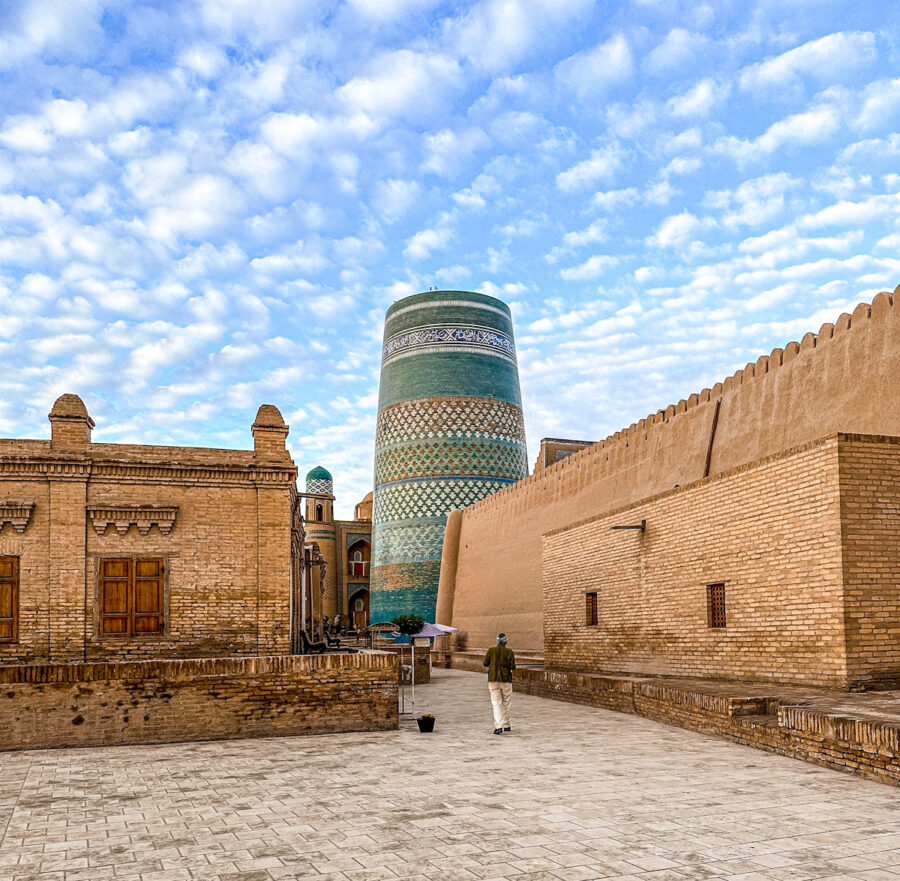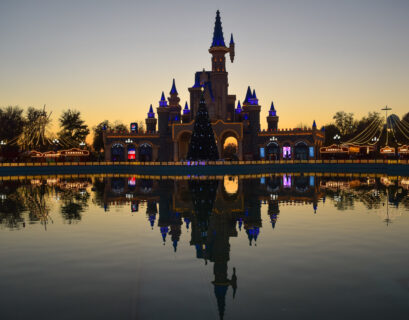Khiva is often referred to as a “living museum,” where ancient mosques, crafted from sun-baked mud bricks, and towering fortress walls evoke the mystique of the Silk Road and its legendary caravans. Time appears to stand still within these historic walls. Nestled along the famed Silk Road, Khiva’s narrow streets all converge upon the Itchan Kala, the walled heart of the old city. This fortified area houses around 60 cultural treasures—medieval mosques, opulent palaces, and a wealth of museums, craft studios, and souvenir shops. It’s this unique blend of history and heritage that earned Khiva the title of the ‘2024 Tourism Capital of the Islamic World.’ Yet despite its rich cultural significance, Khiva is often overshadowed by its more famous counterparts, Samarkand and Bukhara. As a result, many travelers miss out on the allure of this hidden gem when exploring Uzbekistan’s Silk Road cities.
So Itchan Kala is where I was headed, entering from the West Gate of the Ota Darwza. And, as in every other Uzbek city, I was captivated by the street shops: one vendor fluffing on the sheepskin fur hats used by locals, a woman on the opposite end selling the local long coats or the Chapans, and then shops selling some antiques, and artisans breaking into smiles to greet the tourists and then heading back to their meticulous work.

The history of Khiva
Khiva has a long enviable history. From being a centre of slave trade and history dotted with episodes of barbarism, to being centre of art and mathematics, Khiva has seen many shades. I was amazed to learn that Khiva was the birthplace of the ninth-century polymath Al-Khwarizmi, who’s often described as the father of algebra and gives his name to the scientific term ‘algorithm’. Or the legend that Khiva was founded by Shem, one of the sons of Noah, the Old Testament prophet who built an ark. Until the 16th century, Khiva was a secondary city on the Silk Road., or the last stop before traders passed on through the deserts to Persia. Throughout its history, Khiva remained plagued with political and military instability and fell prey to many conquerors such as Persians, Greeks, Arabs, and Mongols. In the 16th century, Khiva became the capital of the new Khanate of Khiva, a kingdom ruled by a khan, and a prosperous slave market on the Silk Road. Then from Khanate, it fell to the Russians in 19th century. About half a century later, it became an autonomous state of People’s Republic of Khorezm, which was eventually absorbed into the Uzbek Soviet Socialist Republic in 1924. The ancient walled city has been a UNESCO World Heritage site since 1990.

UNESCO listed architecture of Khiva
Itchan kala is possibly the best preserved and most impressive destinations on the Silk Road. Now declared an open-air museum, the Itchan Kala is a labyrinth of streets with dozens on intricately decorated monuments. The numerous madrassas boast impressive tilework. Probably the most impressive of these monuments is the Islam Khodja Minaret, Khiva’s tallest (44.5 m) and most recent (1910) minaret. Close to it is an unfinished 19th century, Katla Minar, with turquoise and teal bricks, and probably one of the most iconic landmarks of the walled city.

One can also climb up the Islam Khodja Minaret and take in the surreal views of the walled city from there. At the base of the Madrasa is the Museum of Applied Arts, one of the best places to learn about the cultural past of Khiva.
Just a stone throws away distance is the Kalta Minor, unfinished 19th-century minaret, covered in glazed turquoise and teal bricks and earthenware. The minaret is one of the iconic landscapes of the city. Nearby stands the understated yet elegant Juma Mosque, its roof held aloft by 213 elm columns. Each of these columns is uniquely carved by a different artisan, showcasing their individual craftsmanship.



At its peak, Khiva served both as a welcoming oasis for weary travelers and as a notorious hub for the slave trade. Traders would pause here after the arduous crossing of the Kyzylkum Desert from Bukhara, seeking rest and refreshment, while stocking their caravans with essential supplies before venturing into the harsh desert toward Persia. To preserve Khiva’s rich cultural heritage, the Uzbek government undertook significant efforts, relocating residents outside the fortress walls to restore the once-neglected monuments. Today, the Itchan Kala stands as a vibrant, open-air museum. Its self-contained layout offers visitors an intimate exploration of its historical landmarks and meaningful interactions with the local community.
Venture to the museum inside the Kunya-Ark citadel, to see exhibits that explain how concepts like algebra and algorithm have roots in Khiva, and particularly in the work of Khiva-born mathematician Muhammad ibn Musa al-Khwarizmi.

The best way, however, is to navigate the old town on foot. The town seems like a labyrinth of narrow lanes that opens to wide squares, with minarets, teal tiled mosques, a life-size street statue of two men chatting merrily, a carpet weaving workshop, a ceramic studio, an artists shop somewhere, to some antique tea houses.




Climb the citadel
Tucked away near the northern gate is the Tosh Hauli, or “stone palace,” a hidden gem adorned with pillars and domes, each lavishly covered in vibrant tiles. The palace’s tiles are among the most exquisite I have seen anywhere in Uzbekistan, dazzling in their intricate patterns and vivid colors. Another architectural marvel within the Itchan Kala is the Kunya-Ark Citadel, a grand palace complex dating back to the 12th century. The citadel boasts a stunning summer mosque with walls lined in brilliant blue tiles and a ceiling bursting with multi-colored designs, and an elegantly decorated throne room that captures the grandeur of its time.

Go there at dusk and climb up the steep and narrow steps of the watchtower in search of Khiva’s famed desert sunset. The setting sun offers a panoramic view of the ancient skyline, bathed in a golden hue.
The Khiva vibe
Khiva’s souvenir markets rival those of Samarkand and Bukhara, yet there is a distinct tranquillity here. The atmosphere is refreshingly calm, with no pushy vendors vying for attention. You can wander leisurely through the stalls, take your time to admire the handcrafted treasures, or simply capture them in photographs. Perhaps the best way to soak in the town’s charm is to settle into a chaikhana, sipping tea and breathing in the peaceful ambiance of this historic, artistic town. Though the Silk Road may now be a relic of the past, its importance diminished by more convenient sea routes, sitting in a quiet corner of Khiva, you would be able to feel its enduring legacy in every corner.


To reach: To get to Khiva, there are several options: If you’re coming from Tashkent, the easiest way is to take a flight to Urgench airport, which is about a 45-minute taxi ride from Khiva (expect to pay around 10,000 soms for the ride). The second option would be taking a train to from Tashkent to Urgench. The train journey takes around 17-20 hours. From Urgench, you can take a taxi or a minibus to Khiva.
In case you are covering the Silk Road, more chances you will cover Khiva from Bukhara. Bukhara to Khiva is almost a seven hours train journey. Unfortunately you don’t have high-speed Afrosiyab on this route.
(Follow my Uzbekistan journey here)








